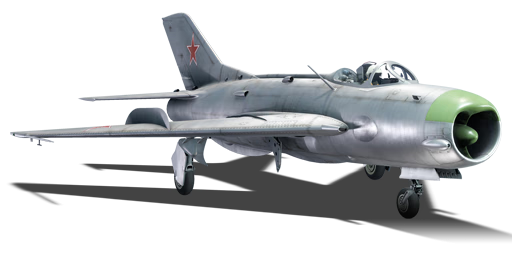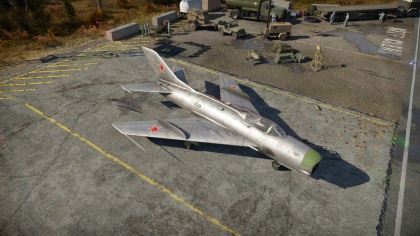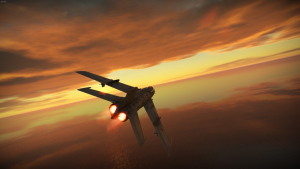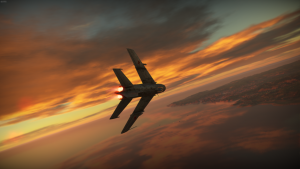Difference between revisions of "MiG-19PT"
(Updated as of 1.91.0.58) |
m (Fixed pros and cons to reflect the MiG-19PT's performance in 1.91) (Tag: Visual edit) |
||
| Line 112: | Line 112: | ||
The '''''{{PAGENAME}}''''' is armed with: | The '''''{{PAGENAME}}''''' is armed with: | ||
| + | |||
* 2 x 30 mm NR-30 cannons, wing-mounted (70 rpg = 140 total) | * 2 x 30 mm NR-30 cannons, wing-mounted (70 rpg = 140 total) | ||
| Line 123: | Line 124: | ||
The '''''{{PAGENAME}}''''' can be outfitted with the following ordnance: | The '''''{{PAGENAME}}''''' can be outfitted with the following ordnance: | ||
| + | |||
* Without load | * Without load | ||
* 2 x R-3S missiles | * 2 x R-3S missiles | ||
| Line 206: | Line 208: | ||
'''Pros:''' | '''Pros:''' | ||
| + | |||
* Higher top speed possible than [[F-100D]] above 6,500 m | * Higher top speed possible than [[F-100D]] above 6,500 m | ||
* Incredibly high rate of climb | * Incredibly high rate of climb | ||
| Line 211: | Line 214: | ||
* Great vertical energy retention | * Great vertical energy retention | ||
* Roll rate superior to the [[MiG-17]] | * Roll rate superior to the [[MiG-17]] | ||
| − | * Incredible acceleration | + | * Incredible acceleration from 600-900 km/h, so it is able to regain energy very fast |
* Has a target detection and tracking radar | * Has a target detection and tracking radar | ||
| + | * Decent manoeuvrability | ||
| + | * | ||
'''Cons:''' | '''Cons:''' | ||
| − | * | + | |
| + | * | ||
* Compression at high speed, wings don't provide as much lift as the Super Sabre | * Compression at high speed, wings don't provide as much lift as the Super Sabre | ||
| − | * | + | * |
* Wings can rip when rolling and turning at high speed | * Wings can rip when rolling and turning at high speed | ||
| − | * | + | * |
* Only two air-to-air missiles, locking range is 0.5 km less than that of the AIM-9B on F-100D | * Only two air-to-air missiles, locking range is 0.5 km less than that of the AIM-9B on F-100D | ||
* Poor low-speed manoeuvrability | * Poor low-speed manoeuvrability | ||
| Line 225: | Line 231: | ||
* Engines are huge; can be easily disabled by enemy fire | * Engines are huge; can be easily disabled by enemy fire | ||
* Radar suite is not as good as the one fitted on the [[Javelin F.(A.W.) Mk.9]] and [[Mitsubishi T-2]] | * Radar suite is not as good as the one fitted on the [[Javelin F.(A.W.) Mk.9]] and [[Mitsubishi T-2]] | ||
| − | * | + | * |
== History == | == History == | ||
| Line 242: | Line 248: | ||
== See also == | == See also == | ||
''Links to the articles on the War Thunder Wiki that you think will be useful for the reader, for example:'' | ''Links to the articles on the War Thunder Wiki that you think will be useful for the reader, for example:'' | ||
| + | |||
* ''reference to the series of the aircraft;'' | * ''reference to the series of the aircraft;'' | ||
* ''links to approximate analogues of other nations and research trees.'' | * ''links to approximate analogues of other nations and research trees.'' | ||
| Line 250: | Line 257: | ||
* ''encyclopedia page on the aircraft;'' | * ''encyclopedia page on the aircraft;'' | ||
* ''other literature.'' --> | * ''other literature.'' --> | ||
| + | |||
* [https://warthunder.com/en/news/5934-development-mig-19pt-target-locked-en [Devblog<nowiki>]</nowiki> MiG-19PT: Target Locked] | * [https://warthunder.com/en/news/5934-development-mig-19pt-target-locked-en [Devblog<nowiki>]</nowiki> MiG-19PT: Target Locked] | ||
{{USSR jet aircraft}} | {{USSR jet aircraft}} | ||
Revision as of 07:04, 14 September 2019
Contents
| This page is about the Russian jet fighter MiG-19PT. For the German version, see MiG-19S (Germany). |
Description
The MiG-19PT is a rank VI Russian jet fighter
with a battle rating of 9.7 (AB/SB) and 9.3 (RB). It was introduced in Update 1.85 "Supersonic" and was one of the first three jets to feature guided air-to-air missiles, the other two being the F-100D and the Javelin F.(A.W.) Mk.9.
General info
Flight performance
Compression at high speeds is an issue for this aircraft. It especially affects the rudder. However, the MiG-19PT generally has a very responsive elevator, although excessive turning will bleed much speed due to the poor energy retention. As with many jets, manoeuvrability is poor at low speeds.
The aircraft has very good acceleration and climb rate.
| Characteristics | |||||||
|---|---|---|---|---|---|---|---|
| Stock | |||||||
| Max Speed (km/h at 10,000 m) |
Max altitude (meters) |
Turn time (seconds) |
Rate of climb (meters/second) |
Take-off run (meters) | |||
| AB | RB | AB | RB | AB | RB | ||
| 1,426 | 1,421 | 17200 | 32.4 | 33.0 | 160 | 149.2 | 500 |
| Upgraded | |||||||
| Max Speed (km/h at 10,000 m) |
Max altitude (meters) |
Turn time (seconds) |
Rate of climb (meters/second) |
Take-off run (meters) | |||
| AB | RB | AB | RB | AB | RB | ||
| ??? | 1,436 | 17200 | ??.? | 32.0 | ??.? | 180 | 500 |
Details
| Features | |||||
|---|---|---|---|---|---|
| Combat flaps | Take-off flaps | Landing flaps | Air brakes | Arrestor gear | Drag Parachute |
| X | ✓ | ✓ | ✓ | X | ✓ |
| Limits | ||||
|---|---|---|---|---|
| Wing-break speed (km/h) |
Gear limit (km/h) |
Combat flaps (km/h) |
Max Static G | |
| + | - | |||
| 700 | ~11 | ~5 | ||
| Optimal velocities | |||
|---|---|---|---|
| Ailerons (km/h) |
Rudder (km/h) |
Elevators (km/h) |
Radiator (km/h) |
| < 540 | < 650 | < 350 | N/A |
| Compressor (RB/SB) | ||
|---|---|---|
| Setting 1 | ||
| Optimal altitude | 100% Engine power | WEP Engine power |
| 0 m | 2,392 kgf | 3,349 kgf |
Survivability and armour
The aircraft is fairly fragile, with any hits likely to damage the engines due to how much space they take up inside the plane. When spaded one engine has enough power to get you back to base, but while stock it is a little harder and you may end up crashing. One benefit of the MiG though is that the elevators are separate to each other in the damage model, and therefore a hit to the tail causing an elevator loss isn't the end of the world, since the remaining one is good enough to continue the fight. Another point to note is that loss of oil in either engine will rapidly cause engine failure, so it is best to return to base ASAP when damaged.
Armaments
Offensive armament
The MiG-19PT is armed with:
- 2 x 30 mm NR-30 cannons, wing-mounted (70 rpg = 140 total)
The MiG-19 carries two 30 mm NR-30 cannons, mounted in the wing roots. Each gun has 70 rounds of ammunition, making a total of 140 rounds. The NR-30 cannons are very fast firing so this is not much ammo, and you can't afford to spray. The guns however are extremely powerful, and only a couple of rounds hitting an enemy aircraft will severely cripple them, if not outright kill them. The shell velocity is very high and you don't need much lead to hit a target.
The recommended belts for this aircraft are Air Targets, with mostly HE rounds, but even the default belts will one hit most of the time. The ground belts contain APHE rounds with 60 mm of penetration, but it is not really worth going for ground targets as the limited ammunition and high speed of the aircraft makes it very difficult to hit or kill anything.
Suspended armament
The MiG-19PT can be outfitted with the following ordnance:
- Without load
- 2 x R-3S missiles
- 2 x R-13M missiles
- 2 x 100 kg OFAB-100 bombs (200 kg total)
- 2 x 250 kg OFAB-250-270 bombs (500 kg total)
- 16 x S-5K rockets
- 32 x S-5K rockets
The MiG-19PT can carry two air to air missiles on under-wing pylons, the R-3S and the R-13M. The R-13M is a higher tier modification than the R-3S, however it is recommended to equip the R-3S due to their lighter weight, higher explosive mass, higher speed and longer engine burn time. The advantage of the R-13M is that it has 1G more G tolerance.
Usage in battles
Describe the tactics of playing in the aircraft, the features of using aircraft in a team and advice on tactics. Refrain from creating a "guide" - do not impose a single point of view, but instead, give the reader food for thought. Examine the most dangerous enemies and give recommendations on fighting them. If necessary, note the specifics of the game in different modes (AB, RB, SB).
Radars
The MiG-19PT is equipped with a RP-5 search and tracking radar. One radar antenna is located in the centre of the air intake, while the other (and the main body of the radar) is located in the nose of the aircraft, above the intake.
| RP-5 - Target Detection Radar | |||
|---|---|---|---|
| Maximum Detection Range |
Guaranteed Detection Range |
Max Azimuth Scan Angle |
Max Elevation Scan Angle |
| 12,000 m | 8,000 m | ±60° | ±40° |
| RP-5 - Target Tracking Radar | |||
| Maximum Tracking Range |
Minimum Tracking Range |
Azimuth Tracking Angle |
Elevation Tracking Angle |
| 4,500 m | 100 m | ±7° | ±7° |
Modules
| Tier | Flight performance | Survivability | Weaponry | |||
|---|---|---|---|---|---|---|
| I | Fuselage repair | Compressor | Offensive 30 mm | FAB-100 | ||
| II | New boosters | Airframe | FAB-250 | R-3S | ||
| III | Wings repair | New 30 mm cannons | S5K | |||
| IV | G-suit | Engine | Cover | R-13M | ||
Pros and cons
Pros:
- Higher top speed possible than F-100D above 6,500 m
- Incredibly high rate of climb
- Hard-hitting guns, low recoil effects due to wing root placement
- Great vertical energy retention
- Roll rate superior to the MiG-17
- Incredible acceleration from 600-900 km/h, so it is able to regain energy very fast
- Has a target detection and tracking radar
- Decent manoeuvrability
Cons:
- Compression at high speed, wings don't provide as much lift as the Super Sabre
- Wings can rip when rolling and turning at high speed
- Only two air-to-air missiles, locking range is 0.5 km less than that of the AIM-9B on F-100D
- Poor low-speed manoeuvrability
- Ventral fin will impact the ground during takeoff if the rotation is prematurely initiated resulting in the tail breaking off
- Engines are huge; can be easily disabled by enemy fire
- Radar suite is not as good as the one fitted on the Javelin F.(A.W.) Mk.9 and Mitsubishi T-2
History
After taking its first flight in 1954, the MiG-19 became a worldwide sensation – it was the first mass-produced aircraft capable of breaking the sound barrier in horizontal flight after taking off from the ground. Although it was the most advanced combat aircraft of its day, the MiG-19 also had certain problems with maneuverability, and certain other improvements also took shape that were then used in the upgraded versions of the MiG-19. The fighter received an all-movable stabilizer that significantly improved its flight characteristics, enhanced control and braking systems, and new, more powerful 30mm guns instead of 23mm guns. One of the most interesting modifications was the MiG-19PT fighter-interceptor, which was developed especially for the installation of K-13 (P-3C) air-to-air missiles. This missile was strongly influenced by the extremely successful American Sidewinder, models of which the Soviet Union received from China. The MiG-19PT's flight tests were successfully completed in 1964. The K-13 missile was then used on an entire series of combat aircraft and remained in active use until the end of the 80s. The MiG-19 itself was modernized several times and participated in many armed conflicts. Over 2,000 MiG-19s were manufactured in the USSR, and even more MiGs were manufactured in China: over 4,500 units.
- From Devblog
Media
See also
Links to the articles on the War Thunder Wiki that you think will be useful for the reader, for example:
- reference to the series of the aircraft;
- links to approximate analogues of other nations and research trees.
External links
| USSR jet aircraft | |
|---|---|
| Bereznyak-Isayev | BI |
| Yakovlev | Yak-15 · Yak-15P · Yak-17 · Yak-23 · Yak-28B · Yak-30D · Yak-38 · Yak-38M · Yak-141 |
| Mikoyan-Gurevich | MiG-9 · MiG-9 (l) · MiG-15 · MiG-15bis · MiG-15bis ISh · MiG-17 · MiG-17AS · MiG-19PT |
| MiG-21F-13 · MiG-21PFM · MiG-21S (R-13-300) · MiG-21SMT · MiG-21bis | |
| MiG-23M · MiG-23ML · MiG-23MLD · MiG-27M · MiG-27K | |
| MiG-29 · MiG-29SMT | |
| Lavochkin | La-174 · La-15 · La-200 |
| Sukhoi | Su-9 · Su-11 |
| Su-7B · Su-7BKL · Su-7BMK · Su-17M2 · Su-17M4 · Su-22M3 | |
| Su-24M | |
| Su-25 · Su-25BM · Su-25K · Su-25T · Su-25SM3 · Su-39 | |
| Su-27 · Su-27SM | |
| Su-34 | |
| Ilyushin | IL-28 · IL-28Sh |
| Tupolev | Tu-14T |







